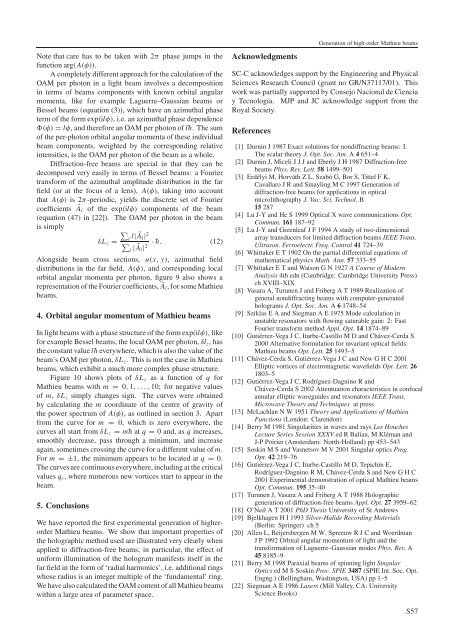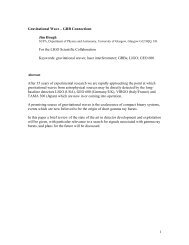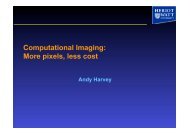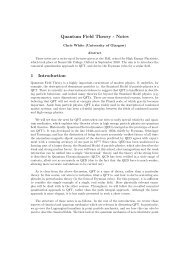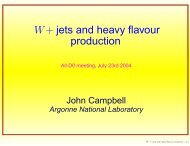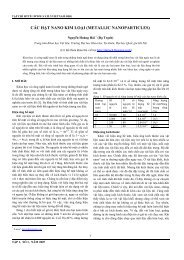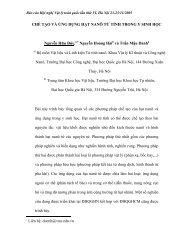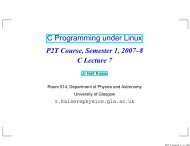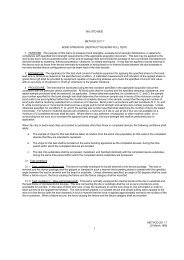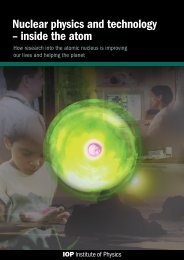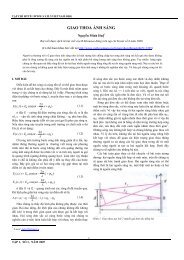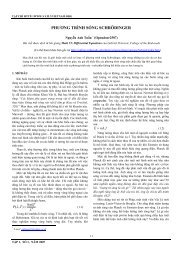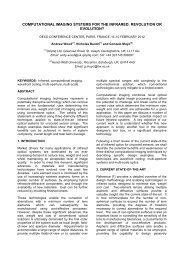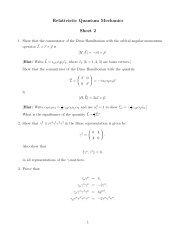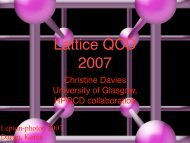Holographic generation and orbital angular momentum of high ...
Holographic generation and orbital angular momentum of high ...
Holographic generation and orbital angular momentum of high ...
Create successful ePaper yourself
Turn your PDF publications into a flip-book with our unique Google optimized e-Paper software.
Note that care has to be taken with 2π phase jumps in thefunction arg(A(φ)).A completely different approach for the calculation <strong>of</strong> theOAM per photon in a light beam involves a decompositionin terms <strong>of</strong> beams components with known <strong>orbital</strong> <strong>angular</strong>momenta, like for example Laguerre–Gaussian beams orBessel beams (equation (3)), which have an azimuthal phaseterm <strong>of</strong> the form exp(ilφ), i.e. an azimuthal phase dependence(φ) = lφ, <strong>and</strong> therefore an OAM per photon <strong>of</strong> l¯h. Thesum<strong>of</strong> the per-photon <strong>orbital</strong> <strong>angular</strong> momenta <strong>of</strong> these individualbeam components, weighted by the corresponding relativeintensities, is the OAM per photon <strong>of</strong> the beam as a whole.Diffraction-free beams are special in that they can bedecomposed very easily in terms <strong>of</strong> Bessel beams: a Fouriertransform <strong>of</strong> the azimuthal amplitude distribution in the farfield (or at the focus <strong>of</strong> a lens), A(φ), taking into accountthat A(φ) is 2π-periodic, yields the discrete set <strong>of</strong> Fouriercoefficients à l <strong>of</strong> the exp(ilφ) components <strong>of</strong> the beam(equation (47) in [22]). The OAM per photon in the beamis simply∑lδL z =l|à l | 2∑l |à · ¯h. (12)l |2Alongside beam cross sections, u(x, y), azimuthal fielddistributions in the far field, A(φ), <strong>and</strong> corresponding local<strong>orbital</strong> <strong>angular</strong> momenta per photon, figure 9 also shows arepresentation <strong>of</strong> the Fourier coefficients, à l , for some Mathieubeams.4. Orbital <strong>angular</strong> <strong>momentum</strong> <strong>of</strong> Mathieu beamsIn light beams with a phase structure <strong>of</strong> the form exp(ilφ), likefor example Bessel beams, the local OAM per photon, δl z ,hasthe constant value l¯h everywhere, which is also the value <strong>of</strong> thebeam’s OAM per photon, δL z . This is not the case in Mathieubeams, which exhibit a much more complex phase structure.Figure 10 shows plots <strong>of</strong> δL z as a function <strong>of</strong> q forMathieu beams with m = 0, 1,...,10; for negative values<strong>of</strong> m, δL z simply changes sign. The curves were obtainedby calculating the m coordinate <strong>of</strong> the centre <strong>of</strong> gravity <strong>of</strong>the power spectrum <strong>of</strong> A(φ), as outlined in section 3. Apartfrom the curve for m = 0, which is zero everywhere, thecurves all start from δL z = m¯h at q = 0 <strong>and</strong>, as q increases,smoothly decrease, pass through a minimum, <strong>and</strong> increaseagain, sometimes crossing the curve for a different value <strong>of</strong> m.For m =±1, the minimum appears to be located at q = 0.The curves are continuous everywhere, including at the criticalvalues q c , where numerous new vortices start to appear in thebeam.5. ConclusionsWe have reported the first experimental <strong>generation</strong> <strong>of</strong> <strong>high</strong>erorderMathieu beams. We show that important properties <strong>of</strong>the holographic method used are illustrated very clearly whenapplied to diffraction-free beams; in particular, the effect <strong>of</strong>uniform illumination <strong>of</strong> the hologram manifests itself in thefar fieldintheform<strong>of</strong>‘radial harmonics’, i.e. additional ringswhose radius is an integer multiple <strong>of</strong> the ‘fundamental’ ring.We have also calculated the OAM content <strong>of</strong> all Mathieu beamswithin a large area <strong>of</strong> parameter space.AcknowledgmentsGeneration <strong>of</strong> <strong>high</strong>-order Mathieu beamsSC-C acknowledges support by the Engineering <strong>and</strong> PhysicalSciences Research Council (grant no GR/N37117/01). Thiswork was partially supported by Consejo Nacional de Cienciay Tecnologia. MJP <strong>and</strong> JC acknowledge support from theRoyal Society.References[1] Durnin J 1987 Exact solutions for nondiffracting beams: I.The scalar theory J. Opt. Soc. Am. A 4 651–4[2] DurninJ,MiceliJJJ<strong>and</strong>EberlyJH1987 Diffraction-freebeams Phys.Rev.Lett.58 1499–501[3] Erdélyi M, Horváth Z L, Szabó G, Bor S, Tittel F K,Cavallaro J R <strong>and</strong> Smayling M C 1997 Generation <strong>of</strong>diffraction-free beams for applications in opticalmicrolithography J. Vac. Sci. Technol. B15 287[4] Lu J-Y <strong>and</strong> He S 1999 Optical X wave communications Opt.Commun. 161 187–92[5] Lu J-Y <strong>and</strong> Greenleaf J F 1994 A study <strong>of</strong> two-dimensionalarray transducers for limited diffraction beams IEEE Trans.Ultrason. Ferroelectr. Freq. Control 41 724–39[6] Whittaker E T 1902 On the partial differential equations <strong>of</strong>mathematical physics Math. Ann. 57 333–55[7] Whittaker E T <strong>and</strong> Watson G N 1927 A Course <strong>of</strong> ModernAnalysis 4th edn (Cambridge: Cambridge University Press)ch XVIII–XIX[8] Vasara A, Turunen J <strong>and</strong> Friberg A T 1989 Realization <strong>of</strong>general nondiffracting beams with computer-generatedholograms J. Opt. Soc. Am. A 6 1748–54[9] Sziklas E A <strong>and</strong> Siegman A E 1975 Mode calculation inunstable resonators with flowing saturable gain: 2: FastFourier transform method Appl. Opt. 14 1874–89[10] Gutiérrez-Vega J C, Iturbe-Castillo M D <strong>and</strong> Chávez-Cerda S2000 Alternative formulation for invariant optical fields:Mathieu beams Opt. Lett. 25 1493–5[11] Chávez-Cerda S, Gutiérrez-Vega J C <strong>and</strong> New G H C 2001Elliptic vortices <strong>of</strong> electromagnetic wavefields Opt. Lett. 261803–5[12] Gutiérrez-Vega J C, Rodríguez-Dagnino R <strong>and</strong>Chávez-Cerda S 2002 Attentuation characteristics in confocalannular elliptic waveguides <strong>and</strong> resonators IEEE Trans.Microwave Theory <strong>and</strong> Techniques at press[13] McLachlan N W 1951 Theory <strong>and</strong> Applications <strong>of</strong> MathieuFunctions (London: Clarendon)[14] Berry M 1981 Singularities in waves <strong>and</strong> rays Les HouchesLecture Series Session XXXV ed R Balian, M Kléman <strong>and</strong>J-P Poirier (Amsterdam: North-Holl<strong>and</strong>) pp 453–543[15] Soskin M S <strong>and</strong> Vasnetsov M V 2001 Singular optics Prog.Opt. 42 219–76[16] Gutiérrez-Vega J C, Iturbe-Castillo M D, TepichínE,Rodríguez-Dagnino R M, Chávez-Cerda S <strong>and</strong> New G H C2001 Experimental demonstration <strong>of</strong> optical Mathieu beamsOpt. Commun. 195 35–40[17] Turunen J, Vasara A <strong>and</strong> Friberg A T 1988 <strong>Holographic</strong><strong>generation</strong> <strong>of</strong> diffraction-free beams Appl. Opt. 27 3959–62[18] O’Neil A T 2001 PhD Thesis University <strong>of</strong> St Andrews[19] Bjelkhagen H I 1993 Silver-Halide Recording Materials(Berlin: Springer) ch 5[20] Allen L, Beijersbergen M W, Spreeuw R J C <strong>and</strong> WoerdmanJ P 1992 Orbital <strong>angular</strong> <strong>momentum</strong> <strong>of</strong> light <strong>and</strong> thetransformation <strong>of</strong> Laguerre–Gaussian modes Phys. Rev. A45 8185–9[21] Berry M 1998 Paraxial beams <strong>of</strong> spinning light SingularOptics ed M S Soskin Proc. SPIE 3487 (SPIE Int. Soc. Opt.Engng.) (Bellingham, Washington, USA) pp 1–5[22] Siegman A E 1986 Lasers (Mill Valley, CA: UniversityScience Books)S57


